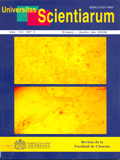Abstract
Se caracterizaron familias a riesgo de inseguridad alimentaria mediante el Sistema de Identificación y Monitoreo de la Vulnerabilidad Alimentaria - SIMVA, Programa Mundial de Alimentos (PMA). Fueron analizadas las características demográficas del hogar y la familia, la disponibilidad y acceso a alimentos, el acceso a bienes y servicios, entre otros, para focalizar recursos y diseñar intervenciones con la población en vulnerabilidad. El estudio se realizó en una institución beneficiaria de la Fundación Banco Arquidocesano de Alimentos - Bogotá, en 18 familias con menores de cinco años que presentaron déficit nutricional, agudo o crónico, según antropometría. Las variables con mayor vulnerabilidad fueron: participación comunitaria, lactancia materna en menores entre 6 meses a 2 años, participación en programas de ayuda alimentaria, desayuno y cena en menores de 18 años, consumo de proteína de alto valor biológico, rechazo de las familias al consumo de verduras y hortalizas, remplazo de alimentos no convenientes para mantener una dieta saludable, acceso a crédito y algún tipo de ahorro, morbilidad aguda en menores de 5 años, consulta a servicios de salud exclusivamente por enfermedad. Se recomendó a las instituciones integrantes del Sistema Local de Bienestar Familiar dirigir acciones y recursos para disminuir los factores de riesgo a mayor vulnerabilidad alimentaria.
Palabras clave: vulnerabilidad alimentaria, seguridad alimentaria, antropometría.
Abstract
Families at risk of food insecurity were characterized with the System for Identification and Surveillance of Food Vulnerability, SIMVA, developed by the World Food Program, WFP. Aspects such as household and family demographic characteristics, food availability, food access, and access to goods and services, among others, were evaluated in order to direct resources and interventions towards the population in vulnerability. Study was conducted in a beneficiary institution of the Food Bank Foundation, Archidiocese of Bogotá, inside eighteen families with children under 5 years old which were classified by anthropometric standards as having acute or chronic nutritional deficit. Factors with highest vulnerability were: community participation; breast feeding in children from 6 to 24 months old; participation in food assistance programs; breakfast and dinner for people under 18 years old; intake of protein of high biological value; rejection of families to eat vegetables; substitution of non convenient foods to maintain a healthy diet; access to credit and savings; acute morbidity in children under five years old; visits to health services only in case of illness. Recommendations were issued to institutions that belong to the Local Family Welfare System to direct actions and resources to those risk factors identified and mentioned before.
Key words: food vulnerability, food insecurity, anthropometry.
Univ. Sci. is registered under a Creative Commons Attribution 4.0 International Public License. Thus, this work may be reproduced, distributed, and publicly shared in digital format, as long as the names of the authors and Pontificia Universidad Javeriana are acknowledged. Others are allowed to quote, adapt, transform, auto-archive, republish, and create based on this material, for any purpose (even commercial ones), provided the authorship is duly acknowledged, a link to the original work is provided, and it is specified if changes have been made. Pontificia Universidad Javeriana does not hold the rights of published works and the authors are solely responsible for the contents of their works; they keep the moral, intellectual, privacy, and publicity rights. Approving the intervention of the work (review, copy-editing, translation, layout) and the following outreach, are granted through an use license and not through an assignment of rights. This means the journal and Pontificia Universidad Javeriana cannot be held responsible for any ethical malpractice by the authors. As a consequence of the protection granted by the use license, the journal is not required to publish recantations or modify information already published, unless the errata stems from the editorial management process. Publishing contents in this journal does not generate royalties for contributors.



